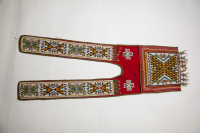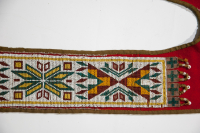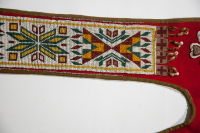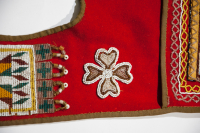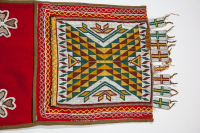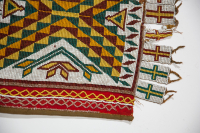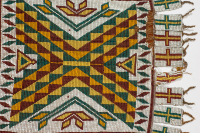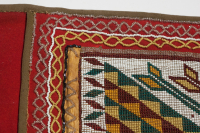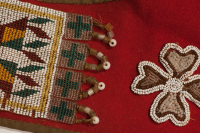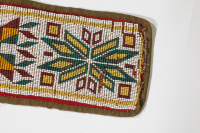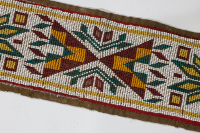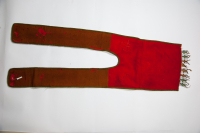Bandolier bag
Bandolier bag
Bandolier bag
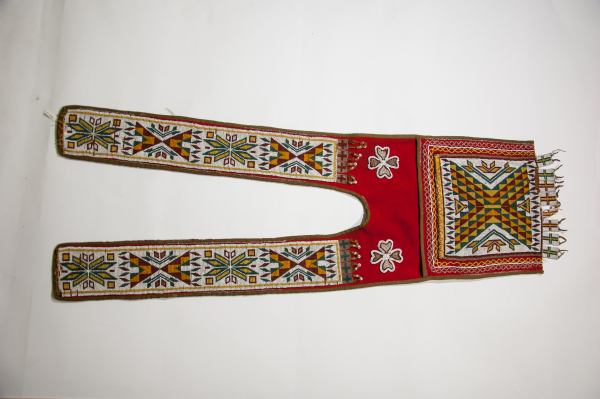
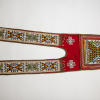
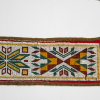
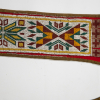

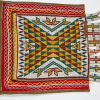
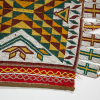
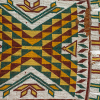
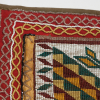
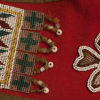
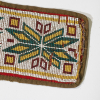
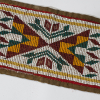
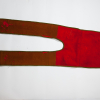
Bandolier, geometric loom-woven beadwork on a white field, overcast stitched beaded 4-petaled flowers, functional pocket, beaded tabs, end with tube beads
Based on catalogue record
Read More About This Relative
Fabric, heavyweight, wool, red and brown, Bias tape, cotton?, green, Thread, cotton, brown, Glass beads: small pony beads, opaque white, large tube beads, white and yellow, Small tube beads, glass, opaque black & opaque brown, Seed beads, glass, white (opaque white, opaque pearly white), clear, red (transparent garnet), orange (opaque yam), yellow (opaque greasy lemon), green (transparent pine).
Hand sewn, Bandolier composed of a large rectangular shaped panel of two shoulder straps not joined, Rectangular stroud bag with square storage pocket, Loom-woven beadwork (single warp with double weft), Trimmed with green bias tape, stitched together with brown cotton thread, Overcast stitched beadwork.
Mirror image straps, Geometric figures, four-lobed flower, square, parallelogram, triangle, interlocking diamond?, zigzag motif, X-shaped motif?, cross?, equal-armed cross?.
Animal and human forms traditionally have had spiritual meaning, often referring to dream experiences, though they have also been used decoratively, particularly in 20th-century work. The decorative animal representations-retain a sense of relationship with animal life that has been inherent in the culture throughout its history. Animal, human, and bird images continue to have spiritual significance when used in relation to religious experiences. The abstract patterns which formed a major part of Ojibwa arts in pre-contact times are not merely decorative, but have references to the surrounding environment and its spiritual associations. In this sense they relate both to the early animal designs and the floral designs which developed after European contact and for which the Ojibwa are best known. [pp 14, 15 – “Living Tradition in Ojibwa Beadwork and Quillwork” by Edna J. Garte]
Bandolier bags most likely originated in the Upper Great Lakes region during the 1840s and 1850s. Fashioned exclusively from European materials and adorned with thousands of beads, bandolier bags were primarily for show, as a symbol of identity, wealth and status. Although initially functional, by the late 19th and early 20th centuries many of the bags had false pockets or none at all. Sometimes called "friendship bags", they were often created as gifts to strengthen relationships within communities or between nations. By the 1870s they had become an important element of formal dress worn mainly at ceremonies and celebrations by men, and occasionally by women. They wore them - singly or several at a time - crossed over the torso or draped around the neck. “The wearing of more than one bag was generally the prerogative of a leader or a person of high honour." (McCord, 2013) “Bandoliers were adopted by Ojibwa in 19th century after seeing bullet pouches used by British soldiers. Bullet pouches were plain and decorated with crest or coat of arms. When idea adopted by Ojibwa, they were greatly prized and highly decorated ceremonial accessories. They became so highly prized by Ojibwa and other tribes (especially Sioux), that one bandolier could be traded for one pony. They became a status symbol of highest ranking Midewiwin priests.(Flanders, 1977)
Provenance
Bandolier may have been acquired by Reverend Pritchard during his missions at Denorwic or Eagle Lake, Ontario or at his brother Tom's mission at Lac Seul, Ontario
McCord Museum, Wearing Our Identity. Montreal: The McCord Museum, 2013; and “Beads: Their Use By Upper Great Lakes Indians” by Richard Flanders, 1977
McCord Museum. Wearing Our Identity. Montreal: The McCord Museum, 2013. Print.
About This GRASAC Record
Manitoba Museum
Content from the Manitoba Museum's catalog records. Uploaded by Orvis Starkweather as part of their summer internship.













 Knowledge Sharing Platform
Knowledge Sharing Platform

